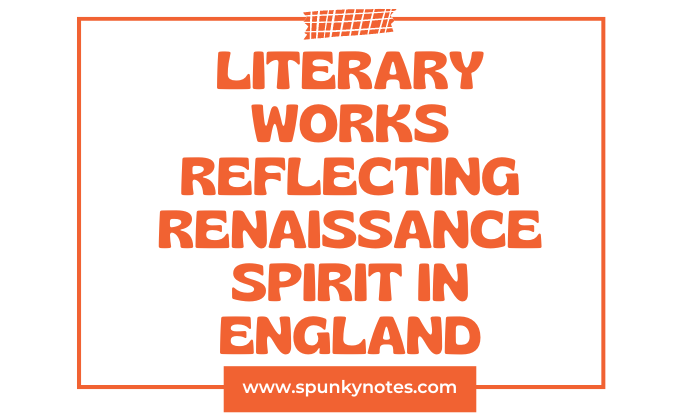

Estimated Reading Time: 6 min

Q. Explore the literary works that reflect the Renaissance spirit in England. Discuss how these works reflect the renewed interest in classical themes, humanism, and individualism.
The English Renaissance was a period of renewed interest in classical themes, humanism, and individualism. This cultural revival was heavily influenced by the rediscovery of Greek and Roman texts, which had a significant impact on English writers.
Many literary works from this time reflect these themes, showing how they were inspired by the classical past and the emerging philosophy of humanism.
Writers such as William Shakespeare, Christopher Marlowe, and Edmund Spenser created works that not only entertained but also explored the value of the individual and the human experience.
William Shakespeare
William Shakespeare’s works are prime examples of Renaissance ideals in English literature. His plays and sonnets often centre around human emotions, characters, and moral dilemmas, reflecting the humanist focus on individual experience.
“Hamlet” is a clear example of this. The play shows Hamlet’s internal struggle with moral choices, revenge, and personal responsibility. Hamlet’s deep contemplation on life, death, and his own identity showcases the Renaissance’s emphasis on individual thought and self-awareness.
Shakespeare also incorporates classical references in his works. In “Julius Caesar”, for example, he uses Roman history to examine power, leadership, and betrayal.
Shakespeare’s use of ancient Roman figures not only connects the Renaissance with classical history but also highlights the importance of individual moral choices and their consequences.
Additionally, Shakespeare’s sonnets emphasize the beauty and complexity of human emotions. His focus on love, time, and mortality in sonnets like Sonnet 18 (“Shall I compare thee to a summer’s day?”) reveals a deep understanding of individual human experiences. The sonnet shows the personal expression and the inner life of individuals.
Christopher Marlowe
Christopher Marlowe was another major playwright of the English Renaissance whose works reflect the era’s spirit. His play “Doctor Faustus” exemplifies Renaissance humanism by focusing on the individual’s quest for knowledge and power.
Faustus, a scholar, sells his soul to the devil in exchange for worldly power and knowledge. This reflects the Renaissance desire to push the boundaries of human potential and knowledge, which was central to the period’s intellectual movement.
However, Faustus’ tragic downfall is a cautionary tale about the dangers of overreaching ambition. Marlowe’s use of classical elements, such as the invocation of Mephistopheles and the themes of hubris, mirrors the ancient Greek and Roman stories of individuals challenging the gods.
Faustus’ story illustrates the Renaissance belief in the importance of the individual while also warning against the reckless pursuit of power without considering moral consequences.
In “Tamburlaine the Great”, Marlowe again emphasizes individualism through the character of Tamburlaine, a conqueror who rises to power through sheer force of will. Tamburlaine’s ambition and success reflect the Renaissance belief in the potential of individuals to shape their own destiny, a significant shift from the medieval focus on divine providence and collective fate.
Edmund Spenser
Edmund Spenser’s “The Faerie Queene” is a monumental work that reflects Renaissance ideals through its allegorical structure, classical references, and humanist themes.
Written as a tribute to Queen Elizabeth I, the poem uses classical mythology and references to explore moral and political virtues. Each book of the poem focuses on a different virtue, such as holiness, temperance, and chastity, reflecting the Renaissance interest in classical ethics and the development of moral character.
Spenser’s use of allegory, where characters represent abstract virtues, is a classical technique that was widely used during the Renaissance.
His reliance on classical themes shows the influence of ancient literature on his work. For example, the knightly quests in “The Faerie Queene” are reminiscent of ancient epic tales, such as those found in Homer’s “The Iliad” or Virgil’s “The Aeneid.”
At the same time, Spenser incorporates humanism into his work by focusing on the moral growth of individuals. The characters in “The Faerie Queene” are not just symbols; they also undergo personal development, learning from their mistakes and growing as individuals.
Sir Philip Sidney
Sir Philip Sidney, another important figure in the English Renaissance, expressed humanist ideas through his poetry and prose.
Astrophel and Stella
His sonnet sequence “Astrophel and Stella” reflects the Renaissance focus on individual emotion and human relationships.
The sonnets describe the feelings of love, longing, and frustration, highlighting the value placed on the individual’s emotional experience during this period.
An Apology for Poetry
In his essay “An Apology for Poetry“, Sidney defends the value of literature and poetry, arguing that poetry teaches moral lessons while also delighting the reader. It reflects the Renaissance belief in the power of literature to improve individuals by fostering moral reflection.
Sidney also draws on classical ideas of poetry as a noble art, aligning himself with ancient Greek and Roman traditions while emphasizing the importance of literature in shaping the individual’s moral character.
Arcadia
Sidney’s “Arcadia”, a pastoral prose romance, also shows his interest in classical themes. The work combines elements of Greek romance with a focus on individual characters’ moral choices and personal growth.
Sidney’s engagement with classical forms and his focus on human emotions and individual experiences make his works representative of Renaissance humanism and its celebration of personal expression.
Renaissance Themes of Humanism and Individualism
Across these works, the Renaissance themes of humanism and individualism are clearly reflected. Humanism, an intellectual movement during the Renaissance, emphasized human beings’ importance, abilities, and moral responsibilities.
This movement rejected the medieval idea that life was solely determined by divine forces. Instead, Renaissance thinkers believed that individuals had the power to shape their own destinies and that their actions had meaning and value.
Individualism was a key theme in the Renaissance, and English literature from this period reflects the growing emphasis on the importance of the individual.
Unlike the medieval focus on collective fate and divine will, Renaissance writers highlighted their characters’ inner lives, personal choices, and moral dilemmas.
The belief that individuals had the power to shape their destinies was central to Renaissance thought, which is clearly seen in the works of key writers like Shakespeare, Marlowe, and Spenser.
For example, in Shakespeare’s “Hamlet,” Hamlet’s internal conflict and struggle with moral choices reflect Renaissance individualism.
His famous soliloquy, “To be, or not to be,” shows a man questioning the nature of existence, suffering, and his own decisions. This emphasis on personal reflection and responsibility was a new focus in literature.
Similarly, Christopher Marlowe’s “Doctor Faustus” centers on an individual who seeks power and knowledge beyond human limits.
Faustus’s decision to sell his soul for personal gain demonstrates the Renaissance belief in the significance of individual choice while also serving as a warning about the potential consequences of unchecked ambition.
Conclusion
The literary works of the English Renaissance have their emphasis on classical themes, humanism, and individualism.
Writers like Shakespeare, Marlowe, Spenser, and Sidney used their works to focus on the individual’s role in society, personal ambition, and the importance of moral decision-making.
By drawing on classical sources and engaging with humanist ideals, these writers helped shape the intellectual and cultural landscape of the Renaissance in England.

